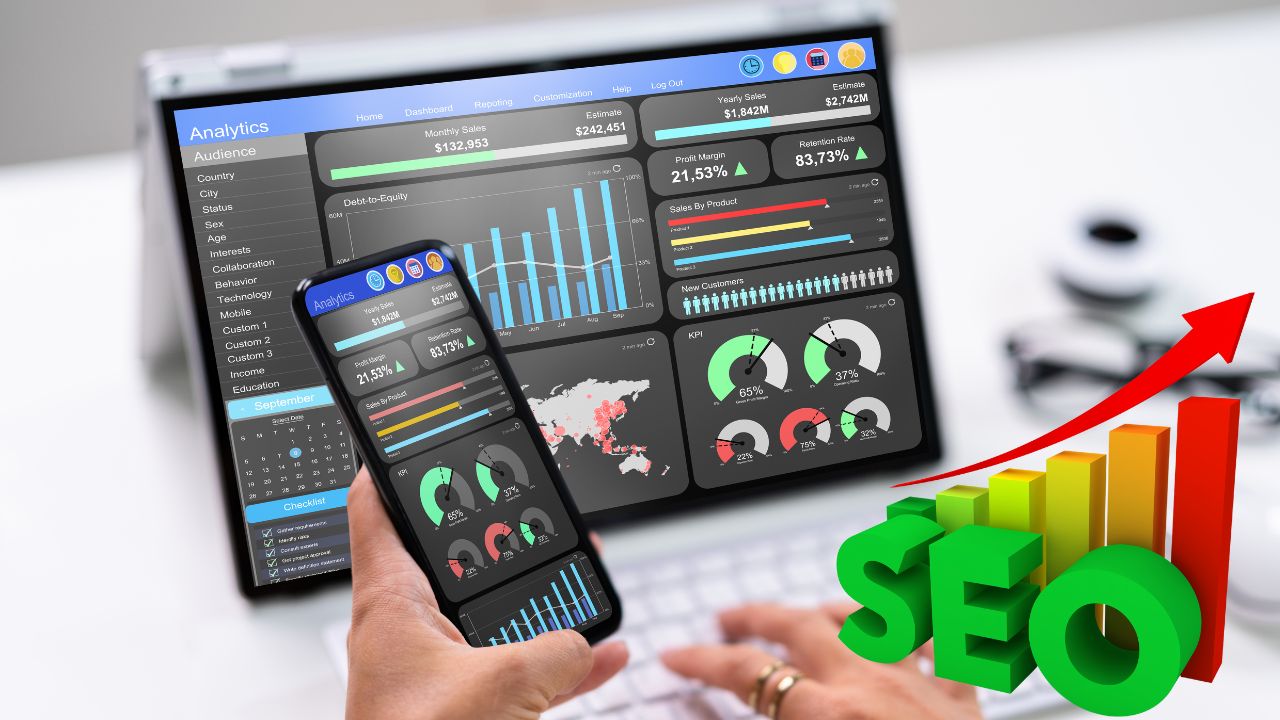What is SEM Data:
Search engine marketing (SEM) is a key tool for businesses today. It helps them reach their audience and achieve real results. The global SEM market is expected to hit $79.27 billion by 2025. This shows how important SEM data is for digital marketing success.
This guide explores What is SEM Data deeply. We’ll look at its basics, how it impacts strategy, and the metrics to track. You’ll see how SEM data can boost ad campaigns, increase ROI, and drive growth in the future.

Key Takeaways
- Understand the fundamentals of search engine marketing and its evolution in the digital landscape
- Explore the core components of SEM data and its strategic impact on business growth
- Discover the key metrics and KPIs crucial for measuring the success of SEM campaigns
- Learn about advanced SEM data analytics tools and their role in driving business intelligence
- Gain insights into the integration of AI and machine learning in SEM for 2025 and beyond
Understanding the Fundamentals of Search Engine Marketing
Starting our journey into search engine marketing (SEM) means first grasping its basics. SEM is a fast-changing field that’s key in today’s digital marketing world.
Key Components of Digital Marketing Strategy
Digital marketing strategies need a mix of parts, with SEM being a big part. Good digital marketers know how to mix SEM with social media, email, and content. This mix helps businesses get seen online and reach their audience better.
The Evolution of SEM in Digital Landscape
What is SEM Data ? SEM has changed a lot over time, keeping up with the digital world. It started with SEO and then moved to PPC ads. As search engines and users got smarter, SEM experts had to keep improving to stay ahead.
Knowing the basics of SEM fundamentals, the main digital marketing strategy parts, and how SEM evolves helps businesses use the internet to their advantage. This leads to real results.
“The only constant in the world of digital marketing is change. Those who embrace the evolution of SEM will be the ones who thrive in the years to come.”
What is SEM Data: Core Concepts and Definitions
Search Engine Marketing (SEM) data is a wide range of metrics and analytics. It gives insights into how well digital marketing campaigns are doing. It shows how SEO and PPC strategies are bringing in traffic, engagement, and conversions.
To understand SEM data’s power, let’s look at some key concepts and definitions:
- SEM data definition: SEM data is the measurable info from search marketing activities. This includes organic search, paid search, and local search. It helps businesses see how well their search engine marketing is doing.
- Search marketing metrics: Important metrics include impressions, clicks, click-through rate (CTR), cost-per-click (CPC), conversion rate, and return on investment (ROI). These metrics show how users behave, how campaigns perform, and the success of the SEM strategy.
- What is SEM used for? SEM data helps improve digital marketing campaigns, increase website visibility, and boost lead generation. It drives business growth. By analyzing SEM data, marketers can make better decisions, use resources wisely, and improve the customer experience.
“SEM data is the lifeblood of modern digital marketing, allowing us to make data-driven decisions and continuously improve our strategies.”
Knowing the core concepts and definitions of SEM data is the first step to using it well. By learning to interpret and apply this valuable info, businesses can succeed more in the digital world.
The Strategic Impact of SEM on Business Growth
Search Engine Marketing (SEM) is a key tool for growing businesses today. It uses data from campaigns to help marketers make smart decisions. This leads to lasting growth.
Measuring ROI Through SEM Campaigns
What is SEM Data , It’s important to know how much SEM costs and what it brings in. By tracking things like click-through rates and conversion rates, businesses can see the real value. This helps them improve their SEM plans.
Converting Data into Business Intelligence
SEM campaigns give a lot of data. By using advanced analytics, companies can turn this data into useful insights. These insights help with product development, content, and more, leading to growth and success.
Market Penetration Strategies
- Leveraging SEM insights to identify new target audiences and underserved market segments
- Optimizing ad campaigns and landing pages to improve conversion rates and acquire new customers
- Developing hyper-targeted content and messaging that resonates with specific buyer personas
- Continuously testing and iterating on SEM strategies to stay ahead of the competition
By linking SEM data to business goals, companies can reach their full digital marketing potential. SEM’s role in business growth is clear, making it essential for any marketing plan.
Key Metrics and KPIs in Search Engine Marketing
What is SEM Data ? In the fast-paced world of search engine marketing, it’s key to track the right metrics and KPIs. This helps businesses see how well their campaigns are doing. By watching these important data points, we can learn a lot. This knowledge helps us make better choices and get more from our marketing.
Let’s look at some top SEM metrics and KPIs you should keep an eye on:
- Click-Through Rate (CTR) – This shows how many people click on your ad after seeing it. A high CTR means your ad is catching people’s attention and interest.
- Conversion Rate – This is how many people do what you want them to do, like buy something or sign up, after clicking your ad. It shows how well your landing pages and overall plan are working.
- Cost-Per-Click (CPC) – This is what you pay for each click on your ad. Keeping an eye on CPC helps you spend your money wisely and get the most out of your ads.
- Return on Ad Spend (ROAS) – This shows how much money you make for every dollar you spend on ads. ROAS is a key sign of how profitable and effective your marketing is.
- Quality Score – Google’s score of how good your ad and landing page are. A higher Quality Score means you might pay less for ads and get better placement, which can boost your campaign’s success.
By keeping a close eye on these SEM metrics and KPIs, we can make smart choices. We can improve our strategies and get the most out of our search engine marketing. Always analyzing and tweaking these important indicators is the key to lasting success in the digital world.
Understanding Keyword Research and Analysis
Effective keyword research is key to a successful search engine marketing (SEM) strategy. It helps us match our marketing with what our audience wants. We’ll look at the differences between long-tail and short-tail keywords and why knowing what users want is important.
Long-tail vs Short-tail Keywords
What is SEM Data ? Long-tail keywords are detailed, multi-word phrases with lower search volume but higher conversion rates. They’re great for targeted SEM campaigns because they attract users with a clear intent. On the other hand, short-tail keywords are broad and may have more searches but are less specific.
Keyword Intent and User Behavior
Knowing what users mean by their search queries is vital for SEM success. By understanding keyword intent, we can make our ads and landing pages more relevant. Also, studying how users behave can give us insights to improve our keyword research and SEM results.

“Comprehensive keyword research is the cornerstone of any successful SEM strategy. It allows us to connect with our target audience at the precise moment they’re ready to engage with our products or services.”
PPC Campaign Structure and Organization
Setting up your pay-per-click (PPC) campaigns right is key to success. It helps you manage your digital marketing well. A good structure ensures your ads and keywords match your goals and audience.
Effective Ad Group Structure
Well-organized ad groups are the base of a great PPC campaign. They should focus on specific themes or products. This lets you tailor your ads and keywords better.
- Group related keywords and ads together for tighter thematic alignment
- Limit the number of keywords per ad group to improve ad relevance and quality score
- Utilize negative keywords to exclude irrelevant searches and improve campaign efficiency
Hierarchical Campaign Organization
Organizing your PPC campaigns in a clear, structured way helps a lot. Here’s how to do it:
- Create top-level campaigns based on broad business objectives or product/service categories
- Within each campaign, establish ad groups focused on more specific themes or target audiences
- Assign highly relevant, semantically related keywords to each ad group
- Develop tailored ad copy and landing pages for each ad group to enhance user experience and conversion rates
With a good PPC campaign structure, you can spot and fix weak spots. You can also grow your best campaigns. This keeps your digital marketing strategy clear and focused.
Good PPC campaign structure and organization are vital for success. They help you manage your campaigns better and align with your business goals. By using these tips, you can make your PPC campaigns work their best and stay competitive online.
Budget Allocation and Bid Management Strategies
What is SEM Data ? In the fast-paced world of search engine marketing (SEM), managing your budget well is key. It’s important to optimize your bids to get the most from your investment. We’ll look at smart bidding technologies and how to optimize your budget.
Smart Bidding Technologies
Smart bidding technologies have changed how we manage bids in SEM. These advanced algorithms use machine learning to analyze lots of data. This includes user behavior, device preferences, and market trends.
They adjust your bids in real-time. This way, you can stay competitive and show your ads to the right people at the best price.
Budget Optimization Techniques
- Dynamic Budget Allocation: Adjust your budget based on how your campaigns are doing and market changes. This can help you get the most from your ad spend (ROAS).
- Granular Bid Strategies: Use specific bid strategies for devices or audiences. This can help you improve your campaigns and get better results.
- Bid Automation: Automating your bid management can save you time and resources. It lets you focus on other parts of your SEM strategy.
By using these strategies, you can make the most of your SEM campaigns. This can help your business grow in a sustainable way.

“Effective budget allocation and bid management are the cornerstones of a successful SEM strategy. By leveraging smart technologies and optimization techniques, you can maximize your ROI and stay ahead of the competition.”
Advanced SEM Data Analytics Tools
What is SEM Data , In today’s fast-changing digital world, SEM analytics tools, data visualization, and performance tracking are crucial. They help us make smart decisions and get the most out of our search engine marketing. These tools are key to success in the digital space.
Modern SEM analytics tools give us a detailed look at our campaigns. They show us important stats like click-through rates and return on investment. With data visualization, we can turn complex data into clear insights. This helps us make better choices and improve our campaigns.
- Gain a deeper understanding of user behavior and search intent through advanced analytics
- Identify high-performing keywords and ad copy to amplify your marketing efforts
- Uncover new opportunities for growth and market penetration by analyzing performance trends
These SEM analytics tools also let us see how our campaigns are doing right away. This means we can adjust quickly to changes in the market. With performance tracking, we can make smart choices, improve our plans, and grow our businesses.
“The ability to transform data into actionable insights is the key to unlocking the full potential of our SEM efforts.”
Looking to the future, using advanced SEM analytics tools, data visualization, and performance tracking is vital. By using these tools, we can improve our marketing, make informed decisions, and ensure our businesses thrive online.
Creating Compelling Ad Copy and Extensions
In the world of search engine marketing (SEM), making great ad copy and using ad extensions well is key. These steps help get more clicks and improve campaign results. Let’s look at how to make your ad copy and extensions work better.
A/B Testing in Ad Creation
A/B testing is a strong tool in SEM. It lets marketers see which ad copy works best. By trying out different headlines, descriptions, and calls-to-action, we learn what our audience likes. This helps us make our ads better and get more people to engage with them.
Extension Strategies for Better CTR
What is SEM Data ? Using ad extensions can make our SEM ads stand out more. Sitelink extensions show more pages, and callout extensions highlight what makes us special. These extras grab attention and get more clicks. By picking the right ad extensions, we make our ads more appealing and informative, which boosts CTR.
| Ad Copy Optimization Tactic | Potential Impact on CTR |
|---|---|
| A/B Testing Headline Variations | Up to 20% increase in CTR |
| Implementing Relevant Ad Extensions | Average 10-15% increase in CTR |
| Crafting Compelling Call-to-Action | Up to 15% increase in CTR |
By getting good at ad copy optimization and using ad extensions well, we can make SEM ads that really grab people’s attention. With a focus on A/B testing, we can keep making our ads better. This leads to better results for our SEM campaigns.

Landing Page Optimization for SEM Success
In the world of search engine marketing (SEM), the landing page is key. It determines the success of your campaigns. Optimizing your landing pages boosts conversion rates and improves user experience. Let’s look at strategies for SEM success through landing page optimization.
Enhancing User Experience
A successful landing page offers a great user experience. It should be visually appealing, easy to use, and simple to navigate. This means optimizing layout, adding clear calls-to-action, and making the conversion process smooth.
- Use responsive design for a consistent experience on all devices
- Keep layouts clean and focused to guide the user
- Make sure pages load quickly to avoid high bounce rates
- Use clear and compelling calls-to-action to encourage action
Aligning Ad Copy and Landing Page Content
It’s important that ad copy and landing page content match. This consistency builds trust and guides the user. It’s key for a smooth conversion process.
- Match the headline and content of the landing page with the ad
- Highlight the benefits and unique selling points from the ad
- Make sure there’s no gap between the ad and the landing page
Optimizing for Conversion Rate
We must also focus on optimizing for higher conversion rates. This means testing different elements, analyzing user behavior, and refining the page for better results.
| Optimization Technique | Potential Impact |
|---|---|
| Streamlining the conversion funnel | Increased conversion rates |
| Implementing social proof elements | Improved credibility and trust |
| Optimizing form fields and submissions | Reduced friction and higher completion rates |
By optimizing landing pages, we can maximize our SEM campaigns’ potential. This leads to business growth. By improving user experience, aligning ad and landing page content, and optimizing for conversion, we set our brands up for success in the digital world.
Mobile SEM Strategies for 2025
The world of digital marketing is changing fast. Mobile devices are becoming more important in our lives. By 2025, mobile SEM will be key for any successful marketing plan.
Mobile-First Optimization
Businesses need to focus on mobile-first optimization for SEM. This means making all marketing materials, like websites and ads, work well on mobile. This way, we can grab the attention of our mobile-loving audience.
App Campaign Integration
What is SEM Data , Integrating app campaigns into our marketing is also crucial for 2025. More people use mobile apps for daily tasks. We need to use this trend to reach our audience. By linking our app campaigns with our SEM strategy, we create a strong mobile marketing plan.
By focusing on mobile-first optimization and app campaigns, we’re ready for 2025. We adapt our SEM strategies to meet our audience’s needs. This opens up new growth opportunities and helps us achieve our business goals.
“The future of search is mobile, and the future of mobile is apps. Integrating these two elements into a cohesive SEM strategy is key to capturing the attention of the modern consumer.”
Integration of AI and Machine Learning in SEM
The digital world is changing fast, and AI and ML are key in Search Engine Marketing (SEM). These technologies are changing how we do search marketing. They offer new chances for businesses to improve their campaigns and succeed more.
Automated bidding systems powered by AI and ML are a big step forward in SEM. These smart algorithms look at lots of data to adjust bids and budgets on the fly. This makes bidding easier and helps ads reach the right people, improving ROI.
AI and ML are also changing predictive analytics in SEM. They find patterns in data that humans can’t, helping marketers guess what customers will do. This means better forecasting and ad choices, making SEM more precise and effective.
What is SEM Data ? As SEM keeps evolving, we’ll see more AI and ML uses. From making ads to targeting the right people, these technologies have a huge impact. Marketers who use AI and ML will lead the way, getting great results for their clients and businesses.
What Does a SEM Manager Do: ultimate role to explore in 2025 Check out here !!
“The integration of AI and machine learning in SEM is not the future – it’s the present. Businesses that fail to leverage these technologies will quickly fall behind their competitors.”
Conclusion
As we wrap up our guide to Search Engine Marketing (SEM) in 2025, it’s clear that SEM data will be key. It will shape the future of digital marketing. By using SEM best practices, businesses can grow a lot and understand their audience better.
The future of SEM looks bright with artificial intelligence and machine learning. These tools will give us deeper insights and make optimization easier. Also, focusing on mobile and apps will become even more important. Businesses that use SEM data well will do great in the future.
In short, SEM is not just a trend. It’s a crucial part of digital marketing success. By knowing the basics, important metrics, and advanced tools, we can make SEM work for us. The future of search marketing is here, and it’s time to use it to our advantage.
Hope this guide gives the clarity of about What is SEM Data ?
FAQ
How to do SEM analysis
Search Engine Marketing (SEM) analysis is a critical process for optimizing your online advertising campaigns and driving measurable results. It involves evaluating keywords, ad performance, and audience targeting to ensure your strategy aligns with business goals and maximizes ROI. By regularly analyzing metrics such as click-through rates, cost-per-click, and conversion rates, you can identify opportunities for improvement and refine your campaigns for greater efficiency and effectiveness.
How to analyse SEM data
Analyzing SEM (Search Engine Marketing) data requires a strategic approach to uncover insights that drive performance. Start by reviewing key metrics like click-through rates (CTR), cost-per-click (CPC), and conversion rates to assess campaign effectiveness. Dive deeper by segmenting data based on audience demographics, ad placements, and keywords to identify trends and optimize future campaigns for better ROI.
What is a benefit of SEM
A key benefit of Search Engine Marketing (SEM) is its ability to deliver immediate visibility and results for businesses in competitive markets. Unlike organic strategies that take time to build momentum, SEM leverages paid advertising to position your website at the top of search engine results, driving targeted traffic almost instantly. This approach not only enhances brand awareness but also provides measurable outcomes, enabling businesses to optimize campaigns and maximize return on investment.
Why is SEM important
Search Engine Marketing (SEM) is a powerful tool for driving targeted traffic to your website, ensuring your business reaches the right audience at the right time. By leveraging paid search strategies, SEM enhances visibility on search engines, helping businesses stand out in competitive markets. With its ability to deliver measurable results and adapt to changing trends, SEM is essential for maximizing online growth and achieving marketing goals.
What is the objective of SEM
The objective of Search Engine Marketing (SEM) is to increase a brand’s visibility and drive targeted traffic to its website through paid advertisements on search engines. By leveraging strategies like pay-per-click (PPC) campaigns, businesses aim to reach users actively searching for their products or services, ensuring high relevance and engagement. Ultimately, SEM seeks to maximize return on investment (ROI) by converting clicks into valuable customer actions, such as purchases, sign-ups, or inquiries.

